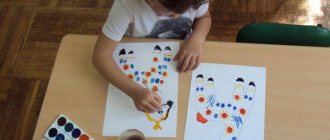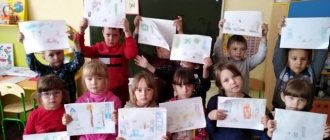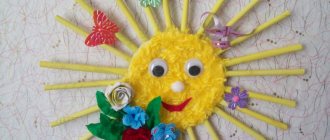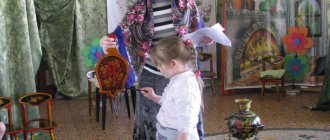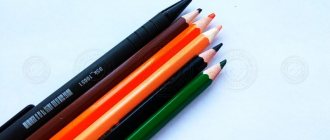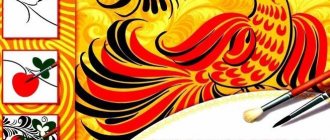Lesson notes for a pre-school group. Getting to know the painting on Khokhloma products
Summary of integrated educational activities in the preparatory school group “Getting to know the painting on Khokhloma products”
Description of work: summary of educational activities on Khokhloma painting in the preparatory school group. Educational activities include practical activities for children - painting paper silhouettes of dishes. Program tasks: Artistic creativity: - Learn to highlight the elements of the Khokhloma painting pattern (leaf, berry, grass). — Continue to teach techniques for painting with a brush the decorative elements of the plant pattern of Khokhloma painting. — Develop color perception and creative imagination. Cognition: - To form knowledge and skills to highlight several qualities of objects in the process of perception. — To cultivate respect for the work of folk craftsmen. Communication: — Improve verbal communication. — Develop the ability to work in a team. — Improve the ability to express your assumptions and draw conclusions. Equipment : reproductions of products from Khokhloma, Gzhel, Dymkovo painting; sheets of paper (silhouettes of dishes) for each child, gouache (watercolor) in red, yellow, green, black, brushes, jars, rags for each child.
Progress of educational activities
I am calling you to a wonderful world.
Today is a special day for us. I invite you friends. Are you ready to go with me? Look at these products guys. Which of them are familiar to you? (Dymkovo and Gzhel). Divide them into groups. Look carefully and find similar ones. Show which products can be combined into a separate group. Let's look at unfamiliar products (Khokhloma). What do they have in common, what unites them? (these products are made of wood, identical patterns: berries, leaves, decorative flowers, “grass”, twigs). What makes these products different from other groups? Khokhloma products are made of wood, and the rest are made of clay and porcelain. Dymkovo and Gzhel paintings are on a white background, and Khokhloma paintings are on black and yellow backgrounds, decorated with patterns. Look, guys, what look like extraordinary golden bowls and spoons. Berries, herbs, leaves, flowers, fabulous firebirds, and fish are painted on them. Such dishes should only be placed on the royal table. How did this miracle “golden Khokhloma” appear? In the old days they said: there once lived in the Nizhny Novgorod forests, on the banks of a quiet river, a man. Nobody knows who he is, where he came from. That man carved wooden cups and spoons and painted them so that they seemed to be made of pure gold. The king found out about this and became angry: “Why don’t I have such a master in my palace? Bring it to me immediately! He tapped his staff, stamped his foot, and called the soldiers to immediately find and take the master to the palace. They searched and searched for the master, but could not find him anywhere. He went to God knows where, but local peasants learned to make “golden” dishes. A lot of “golden” dishes were sold at fairs in the village of Khokhloma. This is how the name “golden Khokhloma” was born. But making real Khokhloma is not at all easy. First, the master carves a blank from wood - the future bowl. Then he dries it and covers it with a thin layer of clay. Now the bowl looks like a clay one, then it is soaked in linseed oil. And for gold, rub the bowl with tin or aluminum powder. The bowl shines like silver. Then the artist draws an intricate pattern with a soft brush. Then the bowl is varnished and placed in an oven to dry, to “harden”. And a miracle happens: the wooden bowl becomes golden, with elegant, colorful designs. I see you are tired. Now we get up and rest a little. Physical education minute. If everything in the world were the same color (rotational movements of the head) would it make you angry? or did it make you happy? (head tilts forward, backward) People are used to seeing the world in yellow, white, blue, red (hands on the belt, body tilts) Let everything around us be amazing and different! (different jumps). - Well done! Let's sit down! Guys, look. I have dishes here: bowls, spoons, vases. This utensil has a yellow gold background. Now you will become masters - artists of Khokhloma and decorate your products with patterns. Who can tell me what plant elements the Khokhloma pattern consists of? (berries, curls, leaves, and also scarlet bunches of rowan, ripe strawberry, curls of herbs and leaves) What colors do we need to make the pattern? (black, red, green) First you need to draw a curved branch with the end of the brush. Then berries and leaves are depicted on the branch (berries - with pokes or the end of a brush, leaves - with the end of a brush or by dipping). Then, near the berries and leaves, you need to draw blades of grass (in arched lines). What is the most important rule when drawing up a pattern? (the pattern should be located at the same distance, repeating the elements evenly) Children’s work.
Guys!
You have turned out to be wonderful craftsmen! When we look at these dishes, what mood do you and I feel? Joyful, cheerful. Now listen to poems about Khokhloma painting . Like the firebird sorceress, the sorceress, the craftswoman, the golden Khokhloma, does not go out of her mind. And rich and beautiful. I am glad to see the guest from the bottom of my heart. Cups, bowls and ladles And what is there: Clusters of fiery rowan berries, sunny poppies and daisies of meadows. I imagined everything, like Dawn’s memory of red rays. And the patterned ornament of ancient Suzdal brocade. The leaves turn red, not thinning from the breath of winter. Enters the kingdom of Berendey, the world of magical Khokhloma. Guys!
Did you enjoy being masters? I'm very glad, we will be masters next week.
We recommend watching:
Master class on Khokhloma painting Plasticineography in Khokhloma patterns. Bunch of rowan. Cup painting. Khokhloma Khokhloma painting. Master class for students in grades 2-3
Similar articles:
Painting a Khokhloma plate
Painting a cutting board. Khokhloma
How and when did Khokhloma originate?
Archives show that beautiful painted dishes were first mentioned in 1659. It was then that a certain boyar named Morozov demanded to collect dishes of various sizes and tin craftsmen from the Trans-Volga lands. In those days, tin was used for gilding. Morozov at that time owned the village of Semenovskoye. In it, as well as in a neighboring village called Khokhloma, a craft for painting wooden products was formed.
The development of such a trade in Rus' was facilitated by the proximity of a large trade route (Volga) and the proximity to the fair - Makaryevskaya. The quality of the dishes was so high that their production was made the main industry for the residents, and the village of Khokhloma became a trading point where unique dishes with unusual designs were sold. After 1916, it was decided to open the School of Artistic Processing of Wooden Products. So Khokhloma received a new round of development.
Materials for painting and stages of preparation for painting
Wooden bases for painting are called “linen”. To make objects from wood, you need not only paint of different shades, but also special purified clay (wapa), which acts as a primer. Drying oil (linseed oil) is also necessary, the correct application of which determines the strength of the pattern.
The next stage is called tinning, which is performed with aluminum powder. It is intensively rubbed into the product, after which the objects acquire shine and are ready for further painting. The paints that the masters use in their work are only oil paints, and the brushes for applying the pattern are mainly squirrel paints.
Varieties of Khokhloma
There are several types of painting in the Khokhloma style. They differ in the method of application and image on wooden objects. Based on the type of application, Khokhloma is divided into the following types:
- background - the design is made on a plain main background, and the ornament is made with gold paint;
- upper – applying a pattern to a ready-made field.
The technique has various painting methods. The most complex technique is applying painting under the background. Initially, the contours of the pattern are applied to the wooden blank, and then some parts begin to be painted over with a black or red background color. After applying the background layer, they begin to make patterns and other complex details.
"Gingerbread"
The simplest method is called “Gingerbread”. In the center of the product there is an image of a geometric figure, for example, a rhombus or a square. Inside it is supplemented with sun, climbing plants, and herbs.
"Grass"
“Travka”, or herbal painting, is applied in abrupt strokes. Leaves are painted with large strokes, blades of grass or dew drops are used with smaller strokes. This element of top painting allows you to fill the entire surface of the product with an openwork pattern. This is one of the most difficult types, which requires patience and special attention from the master.
"Berry"
Another technique called “Berry” is very reminiscent of “Grass”. However, the style looks richer and more decorative than the previous one. It is based on an interweaving of large berries and herbs. As a rule, masters depict strawberries, gooseberries, grapes, and among flowers - chamomile and bell.
"Kudrins"
“Kudrina” is characterized by a certain ornate floral pattern. In this case, the ornament is made with gold paint. The peculiarity of application is to work with a very thin brush.
